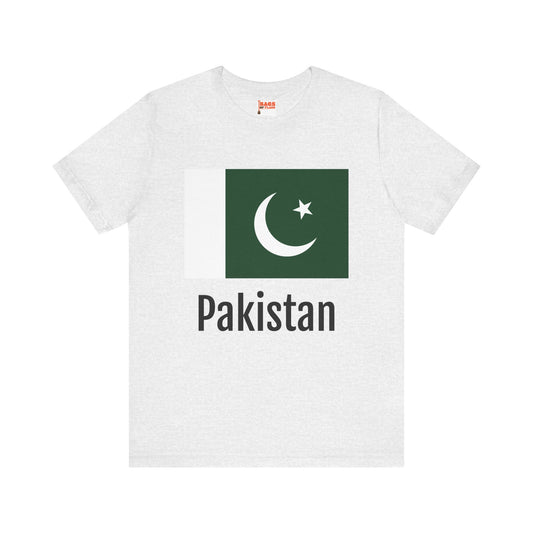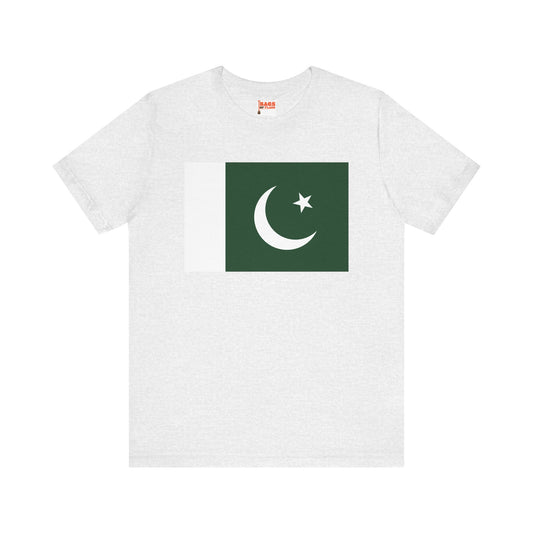-
Pakistan Sweatshirt
Regular price $34.15 USDRegular priceUnit price / per -
Pakistan Flag Sweatshirt
Regular price $34.15 USDRegular priceUnit price / per -
Pakistan Inspired Sweatshirt
Regular price $34.15 USDRegular priceUnit price / per -
Pakistan Backpack
Regular price $59.79 USDRegular priceUnit price / per -
Pakistan Leather Patch Hat
Regular price $18.85 USDRegular priceUnit price / per -
Pakistan Inspired Hoodie
Regular price $34.40 USDRegular priceUnit price / per -
Pakistan T-shirts
Regular price $22.79 USDRegular priceUnit price / per -
Pakistan Flag Hoodies
Regular price $34.40 USDRegular priceUnit price / per -
Pakistan Inspired T-shirt
Regular price $22.79 USDRegular priceUnit price / per -
Pakistan Hoodies
Regular price $34.40 USDRegular priceUnit price / per -
Pakistan Flag on T-shirt
Regular price $22.79 USDRegular priceUnit price / per
Collection: Pakistan
The Pakistan flag, with its distinctive green and white colors and a star and crescent symbol, is a symbol of national pride and identity for the people of Pakistan. We will delve into the mysteries of the Pakistan flag, exploring lesser-known facts, historical contexts, symbolism, current relevance, and unique protocols associated with this iconic national symbol.
Overview of the Pakistan Flag's Design and Colors

At the heart of the Pakistan flag lies a profound combination of colors and symbols that articulate the country's core values and identity. Dominated by a dark green background, the flag carries a significant white vertical stripe at its hoist. This juxtaposition is not merely aesthetic but deeply symbolic. The white star and crescent are central to the flag’s design, set against the green backdrop, creating a striking visual contrast.
The dark green color is symbolic of Pakistan’s majority Muslim population, reflecting the Islamic faith as a cornerstone of the nation's identity. Conversely, the white stripe serves a dual purpose - representing the religious minorities within Pakistan and illustrating the nation’s commitment to peace and harmony among all its citizens. This careful balance of colors and symbols encapsulates the essence of the Pakistani flag, making it a vivid representation of the country’s diversity, religious ethos, and aspirations for unity and progress.
Historical Context of the Pakistan Flag
The flag of Pakistan was adopted in a momentous period of the nation's history, serving as a beacon of hope and identity for its people. The design, unveiled just days before Pakistan emerged as an independent country, has a narrative deeply intertwined with the nation's struggle for independence and self-identity. Its adoption on August 11, 1947, marked a significant milestone in Pakistan's journey, symbolizing the end of British colonial rule and the birth of a new nation carved out on the principles of religious freedom and self-governance.
The brainchild behind this iconic symbol was Amiruddin Kidwai, whose vision was to create a flag that encapsulated the aspirations and values of the Muslim community seeking a separate homeland. Since its first raising on August 14, 1947, the flag has reminded us of the sacrifices for independence and the ongoing quest for national unity and integrity. Its enduring design speaks volumes about the timeless ideals it represents, remaining a potent symbol of the nation's pride and sovereignty through the decades.
Symbolism Embedded in the Flag
The symbolism of the Pakistan flag is multi-faceted, reflecting the country's religious foundations, aspirations, and commitment to unity among its diverse populace. Here's a closer look at the deeper meanings each element of the flag conveys:
-
Green Field:
- Represents Islam, the religion practiced by the majority of Pakistan's population.
- Symbolizes prosperity, progress, and enlightenment.
-
White Stripe:
- Stands for the religious minorities residing within Pakistan, highlighting the nation's commitment to religious freedom and equality.
- Emphasizes peace and harmony among all citizens, regardless of their faith.
-
Crescent and Star:
- The crescent moon is a traditional symbol of Islam but also represents progress.
- The star signifies light and knowledge, guiding the nation toward growth and innovation.
This intricate symbolism in the flag underscores Pakistan's foundational values and aspirations. It serves as a constant reminder of the country's ethos, aiming for harmonious coexistence among its people while progressing forward as a united nation. The thoughtful combination of these symbols encapsulates Pakistan's spirit and identity, echoing its rich cultural heritage and visionary aspirations for the future.
Current Relevance of the Pakistan Flag

Today, the Pakistan flag remains a powerful emblem of national unity and identity, prominently featured in various settings that underscore its ongoing significance. Its presence is unmistakable during national celebrations such as Pakistan Independence Day and Republic Day, symbolizing the country's freedom and sovereignty. Additionally, the flag plays a critical role in military ceremonies, serving as a tribute to the armed forces' commitment and sacrifices and a reminder of the nation's resilience and strength. The flag is equally significant in diplomatic contexts, representing Pakistan on the global stage at international meetings, embassies, and consular offices worldwide.
Despite its widespread use and respect, the flag has occasionally been central to heated discussions and controversies, especially in political spheres. Debates have emerged over the proper use of the flag in protests or political rallies, highlighting the intense emotions and diverse opinions that the symbol evokes among the Pakistani populace. These discussions often reflect broader conversations about national identity, unity, and the flag's values. Yet, through these debates, the flag continues to hold a place of honor in the hearts of many, symbolizing a common heritage and the collective aspirations of the people of Pakistan.
Additional Facts and Protocols Associated with the Pakistan Flag
In adherence to the profound respect the nation holds for its flag, established guidelines dictate its display and handling, reflecting its revered status. Notably, the flag must be hoisted with the utmost care, ensuring it remains aloft and pristine, never making contact with the ground, as a mark of honor and respect. This protocol underscores the flag's holy nature and the collective reverence of the Pakistani people towards this emblem of their nationhood.
Special occasions such as national holidays and significant events are marked by the ceremonious hoisting of the flag, symbolizing Pakistan's unity and indomitable spirit. During these moments, the flag serves as a beacon of the country's sovereignty, reinforcing a sense of national pride and togetherness.
Moreover, during national mourning or crisis periods, the flag is utilized as a powerful symbol of solidarity and resilience, embodying the collective will of the Pakistani people to overcome adversity.
An intriguing aspect of the Pakistan flag is its historical lineage, tracing back to the flag of the All-India Muslim League, underscoring the enduring legacy and ideological foundations that led to the formation of Pakistan. This connection highlights the flag's significance as a national symbol and a testament to the country's historical journey towards independence and self-determination.






















